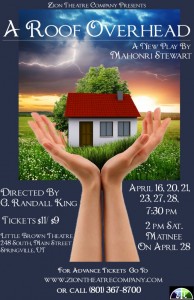Review
=====
 Title: A Roof Overhead, and Other Plays
Title: A Roof Overhead, and Other Plays
Author: Mahonri Stewart
Publisher: Zarahemla Books
Genre: Drama
Year Published: 2016
Number of pages: 390
Binding: Trade Paperback
ISBN10:
ISBN13: 978-0-9883233-7-7
Price: $17.95
Reviewed by Dennis Clark for the Association for Mormon Letters
With A Roof Overhead, and Other Plays, Mahonri Stewart has given an invaluable gift to those of us who have not seen these plays in production. And while producing the plays in your own head, and reading all the parts yourself, is not an ideal theatrical experience, it is one you should not miss. Not with these plays.
Stewart is very much at ease with historical settings and characters. Three of these five plays — “Friends of God,” “White Mountain” and “Yeshua” — have clearly defined historical settings, and a fourth, “The Prince’s House,” has a setting suggested (by its epigraph and idioms) in Elizabethan England. The only play set in contemporary America, and carefully not further specified as to place, is the title play. But in choosing to open the collection with “Friends of God,” Stewart invites us into territory familiar to Mormon readers — the few days before and after the assassination of Joseph Smith, including that political act of murder.

And Stewart has very clearly chosen to depict it as a political murder. He is very good and blending the story as related in History of the Church with more recent accounts of those several days, and investigating the entire context of the events. He allows all participants to state their cases, although he obviously favors the Smith brothers. And he gives full play to the political element of Joseph Smith’s run for the presidency, and sending out members of the Twelve to campaign for him in the big cities. The link between William Law’s opposition to Joseph’s perceived autocratic and high-handed rule in Nauvoo, and Governor Ford’s unwillingness to protect Joseph in Carthage, is clearly set forth — more clearly perhaps than other historical sources might justify, but relying on John Taylor’s account of the events to clarify the confusion of those few days.
The one weakness of the play is its over-reliance on text as the sources for Joseph’s speech. As clearly as anything can be determined from the historical record, Joseph Smith did not dictate the part of the History of the Church covering those months. And the reconstructed text of, say, the King Follett discourse, delivered at the April General Conference of the Church, shows a far looser speaking style than the written texts Stewart employs. I would like to see in this play the kind of playing with the received text that Stewart employs in “Yeshua.” He should unbind himself not from the historical record but from the diction of those hoping to ennoble the Prophet and project a dignified image of the man. He does this well in such scenes as act 1, scene 4, where Joseph and Hyrum are interrupted in wrestling by William Law, where the stuffiness of the latter is strongly contrasted with the playful glee of the former.
Where he has to imagine the conflicts, as in act 2, scene 1, where William Law is trying to persuade Emma to his anti-polygamist cause and, in a concurrent conversation, Jane Law is trying to persuade Joseph to allow her to be sealed to him, he is strongest. There is no scene 2 in this act, but it may be the scene Stewart says he deleted between Brigham Young and Mary Ann Young, which would fit here in the conflicts over polygamy. However that may be, Stewart clearly has the imagination to break free of the textual sources.
He shows this vividly in the first short play, “White Mountain.” He uses four characters to explore the dynamics of the Restoration, two for whom it is a blessing and two for whom it is a threat. Two of the four are brother and sister, Abraham and Ruth; two are married, Jacob and Ruth; and two are courting, Abraham and Mercy. The latter two are a visionary pair; the former, a decidedly secular couple. But Ruth comes to Abraham, her brother, weeping, because Jacob has left her for the wild frontier — the play is set in “A cabin in Frontier America, 1830s” — but Jacob wants to move further out and Ruth wants to stay and settle. The other couple, Abraham and Mercy, share Jacob’s restlessness, but they are dissatisfied with the spiritual settlement that pleases Ruth and Jacob. They are considering joining up with the Mormons, which appalls Ruth. The twists and turns of this mix make for a delightful, thoughtful exploration of family dynamics.
Family dynamics feature in all these plays, and Stewart is superb at laying them out. The third play, “The Prince’s House,” is the shortest, and features only two characters, Margaret and William. It is a play about demonic possession. William is possessed, and to Margaret falls the task of, first, recognizing that circumstance and, second, repairing it. The setting could be Elizabethan England, but the play focuses so much on the possession that the setting doesn’t make any difference. It is an exploration of the metaphor Jesus employed in of a demon returning to his former haunt and finding it “empty, swept, and garnished.” So he goes and rounds up seven demons worse than himself and they return and possess the man. This is where the play starts. Its family dynamic is Margaret’s attempt to exorcise the demons by her love. It is a loving echo of the last sentence in this parable: “Even so shall it be also unto this wicked generation.” This also features Stewart at his most experimental in his use of language.
 His least experimental use of language features in “A Roof Overhead,” which is set in contemporary America, somewhere in the west, where Mormons are not in the majority. This setting allows the Mormons in the family to be in conflict with their neighbors, their roomer and themselves, without requiring any extra effort of the imagination. This is the weakest and most dramatic of the five plays, relying as it does on a shocking tragedy that seems a bit like a *deus ex machina.* But as it moves towards its resolution, if you are willing to suspend your disbelief, the family dynamics begin to work by welcoming and forgiving.
His least experimental use of language features in “A Roof Overhead,” which is set in contemporary America, somewhere in the west, where Mormons are not in the majority. This setting allows the Mormons in the family to be in conflict with their neighbors, their roomer and themselves, without requiring any extra effort of the imagination. This is the weakest and most dramatic of the five plays, relying as it does on a shocking tragedy that seems a bit like a *deus ex machina.* But as it moves towards its resolution, if you are willing to suspend your disbelief, the family dynamics begin to work by welcoming and forgiving.
The family dynamics of the fifth and final play, “Yeshua,” are far less mechanical, and yet present a fresh look at a familiar story. This is Stewart’s most daring experiment in historical exploration, and although it does rely on the text of the gospels to explore the life of the Nazarene, it manages to ground the play in the Aramaic world we tend to forget when we think about Jesus. It works from a kind of harmony of the gospels, but fills out the zealots like Barraba and Shimon and Yehuda Sicarri, men who surround Yeshua and attempt to use him in a plot to throw off the Roman yoke. There is a great deal made of the inclusion by Yeshua of women as his disciples, and much made of the family dynamics not only of Yeshua’s birth family and that of the family of Miriam, Marta and Eleazar, but of the family Yeshua creates from those who follow him. As in “Friends of God,” there is no doubt that Yeshua is caught in an intricate political scheme, and that his death is a political murder, and Stewart fills in many of the motives and twists of the events surrounding his death. Here Stewart is most free in his imagination, and the play is his most experimental in its staging.
There is no evidence that it was ever staged, which is a shame. It should be. But had it been staged, and the script worked over in production, I wouldn’t need to append this sour note. Or then again, I might. The texts of “A Roof Overhead” and “Yeshua” are both riddled with the kind of errors an editor should have caught. I regard this as the responsibility of the publisher. There are two kinds of errors involved: simple spelling or syntactical errors, which appear in both texts, and contemporary idioms that mar the attempt to produce the feel of a Galilean idiom, things like Ya’aqov Alphaeus commenting on the miracle of loaves and fishes, saying “I’m still trying to wrap my head around it.” That blew my mind, and other metaphors from the druggie culture of my youth. These many blemishes, far more than I would expect from a caring publisher, are like the zits and pimples of adolescence. They should disappear with maturity, and Stewart is yet young. I expect further great plays to come from his pen.

Loved your thoughtful, informed response to the plays! Thanks so much for taking the time to read them.